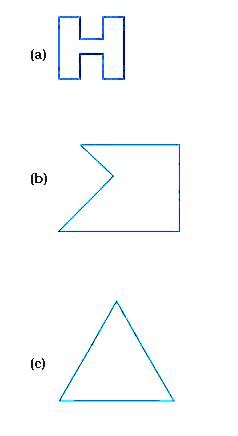Assertion : A parallelogram has no line of symmetry.
Reason : Each regular polygon has as many lines of symmetry as it has sides.
If both assertion and reason are true and reason is the correct explanation of assertion.
If both assertion and reason are true but reason is not the correct explanation of assertion.
If assertion is true but reason is false.
If assertion is false but reason is true.
To solve the question, we need to analyze both the assertion and the reason provided.
1. Understanding the Assertion:
- The assertion states that "A parallelogram has no line of symmetry."
- We need to determine if this statement is true or false.
2. Analyzing the Parallelogram:
- A parallelogram is a quadrilateral with opposite sides that are equal and parallel.
- It has two pairs of opposite sides and two pairs of opposite angles.
3. Finding Lines of Symmetry:
- A parallelogram does have lines of symmetry. Specifically:
- There are two lines of symmetry that can be drawn through the midpoints of opposite sides.
- Additionally, there are two lines of symmetry that can be drawn along the diagonals of the parallelogram.
- Therefore, a parallelogram actually has 2 lines of symmetry (not none).
4. Conclusion on the Assertion:
- Since we found that a parallelogram does have lines of symmetry, the assertion "A parallelogram has no line of symmetry" is false.
5. Understanding the Reason:
- The reason states that "Each regular polygon has as many lines of symmetry as it has sides."
- This statement is true. For example:
- A triangle has 3 sides and 3 lines of symmetry.
- A square has 4 sides and 4 lines of symmetry.
6. Conclusion on the Reason:
- The reason provided is correct.
7. Final Evaluation:
- Since the assertion is false and the reason is true, we conclude that the correct option is that the assertion is false but the reason is true.
Final Answer:
- The assertion is false, and the reason is true.
---
- The assertion states that "A parallelogram has no line of symmetry."
- We need to determine if this statement is true or false.
- A parallelogram is a quadrilateral with opposite sides that are equal and parallel.
- It has two pairs of opposite sides and two pairs of opposite angles.
- A parallelogram does have lines of symmetry. Specifically:
- There are two lines of symmetry that can be drawn through the midpoints of opposite sides.
- Additionally, there are two lines of symmetry that can be drawn along the diagonals of the parallelogram.
- Therefore, a parallelogram actually has 2 lines of symmetry (not none).
- Since we found that a parallelogram does have lines of symmetry, the assertion "A parallelogram has no line of symmetry" is false.
- The reason states that "Each regular polygon has as many lines of symmetry as it has sides."
- This statement is true. For example:
- A triangle has 3 sides and 3 lines of symmetry.
- A square has 4 sides and 4 lines of symmetry.
- The reason provided is correct.
- Since the assertion is false and the reason is true, we conclude that the correct option is that the assertion is false but the reason is true.
- The assertion is false, and the reason is true.
Topper's Solved these Questions
Similar Questions
Knowledge Check
- Question 1 - Select One
A circle has how many lines of symmetry
Ano line symmetryBone line symmetryCtwo line symmetryDan unlimited number of lines of symmetry - Question 2 - Select One
A square has how many lines of symmetry
Aone line of symmetryBtwo lines of symmetryCthree lines of symmetryDfour lines of symmetry
A regular hexagon has six lines of symmetry.
View SolutionDraw all lines of symmetry, if it has.
 View Solution
View SolutionA regular octagon has 10 lines of symmetry.
View SolutionA parallelogram has ______________line of symmetry.
View SolutionA circle has only 16 lines of symmetry.
View SolutionA circle has only 8 lines of symmetry.
View Solution

